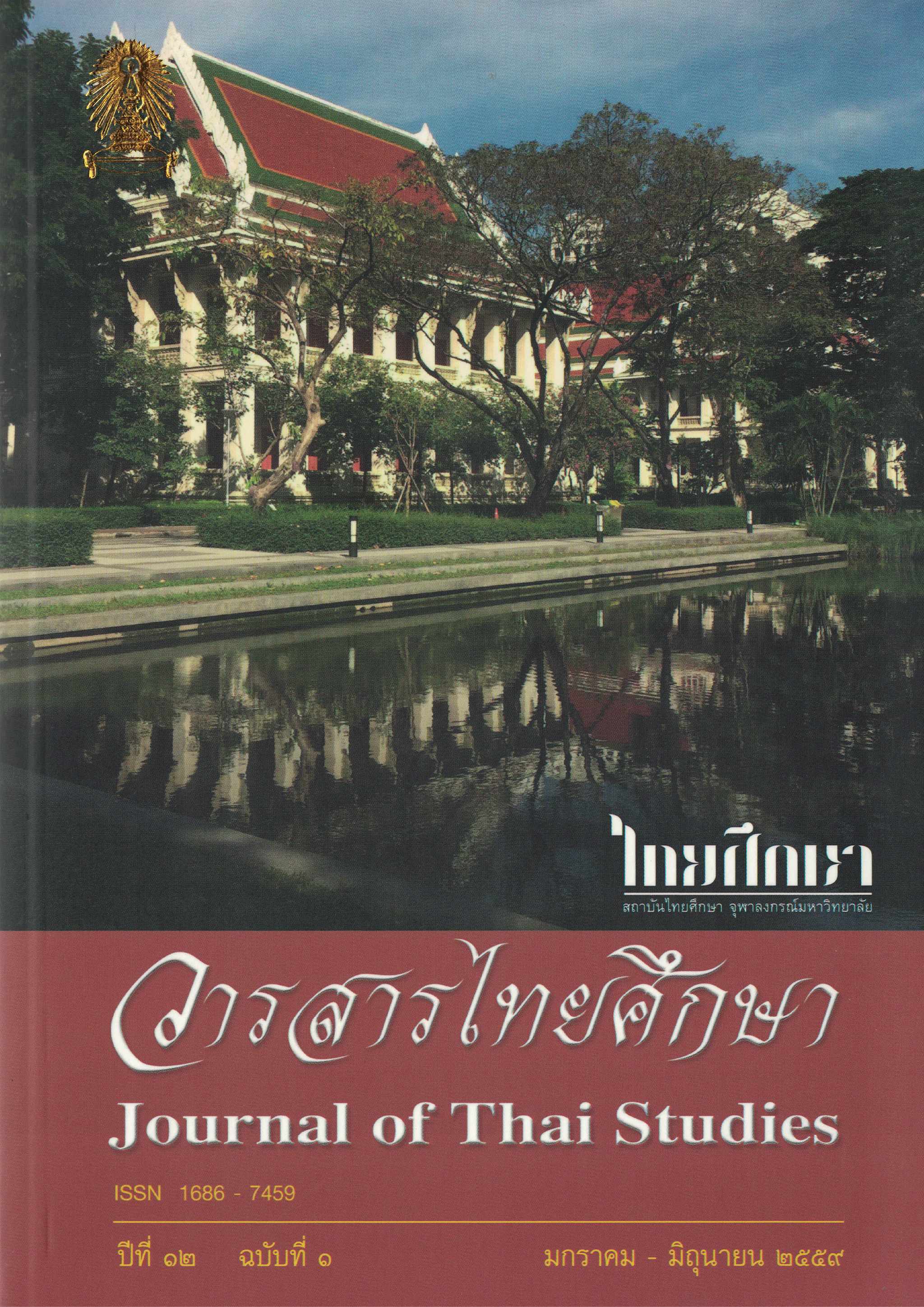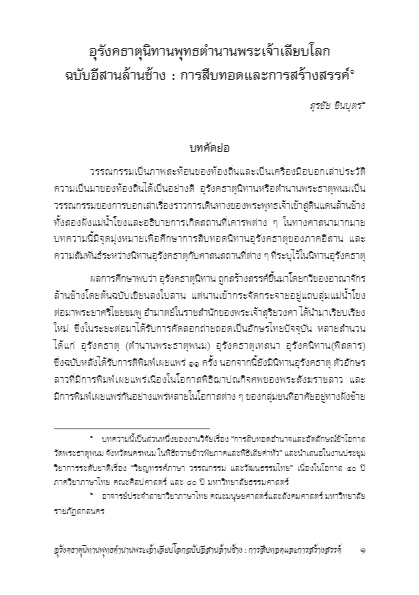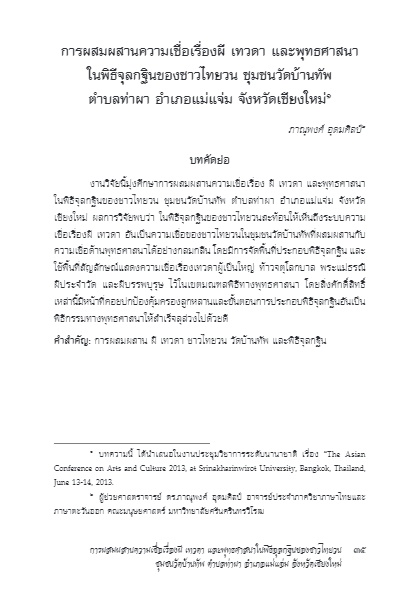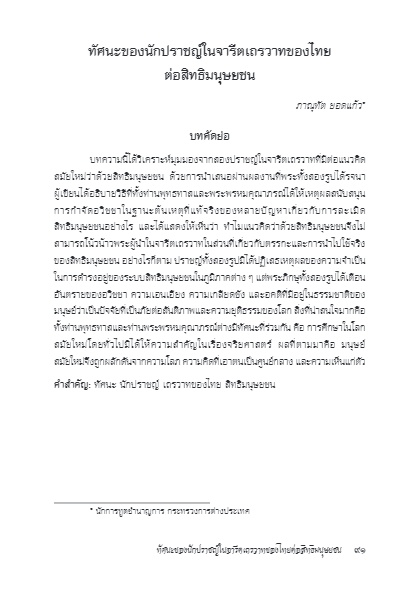วารสารไทยศึกษา - ปีที่ 12 ฉบับที่ 1

1) อุรังคธาตุนิทานพุทธตำนานพระเจ้าเลียบโลกฉบับอีสานล้านช้าง : การสืบทอดและการสร้างสรรค์ / สุรชัย ชินบุตร
2) การผสมผสานความเชื่อเรื่องผี เทวดา และพุทธศาสนาในพิธีจุลกฐินของชาวไทยวน ชุมชนวัดบ้านทัพ ตำบลท่าผา อำเภอแม่แจ่ม จังหวัดเชียงใหม่ / ภาณุพงศ์ อุดมศิลป์
3) การวิเคราะห์ชื่อสร้อยของประชาชนจังหวัดเชียงราย / สุทธา รัตนศักดิ์, พรรณวดี รัตนศักดิ์
4) ทัศนะของนักปราชญ์ในจารีตเถรวาทของไทยต่อสิทธิมนุษยชน / ภาณุทัต ยอดแก้ว
5) “อาชญากรรม” ในวรรณกรรมของชาวบ้านภาคกลางสมัยพระบาทสมเด็จพระจุลจอมเกล้าเจ้าอยู่หัวและพระบาทสมเด็จพระมงกุฎเกล้าเจ้าอยู่หัว / โดม ไกรปกรณ์
อุรังคธาตุนิทานพุทธตำนานพระเจ้าเลียบโลกฉบับอีสานล้านช้าง : การสืบทอดและการสร้างสรรค์
สุรชัย ชินบุตร
บทคัดย่อ
วรรณกรรมเป็นภาพสะท้อนของท้องถิ่นและเป็นเครื่องมือบอกเล่าประวัติ ความเป็นมาของท้องถิ่นได้เป็นอย่างดี อุรังคธาตุนิทานหรือตำนานพระธาตุพนมเป็นวรรณกรรมของการบอกเล่าเรื่องราวการเดินทางของพระพุทธเจ้าเข้าสู่ดินแดนล้านช้างทั้งสองฝั่งแม่น้ำโขง และอธิบายการเกิดสถานที่เคารพต่าง ๆ ในทางศาสนามากมาย บทความนี้มีจุดมุ่งหมายเพื่อศึกษาการสืบทอดนิทานอุรังคธาตุของภาคอีสาน และความสัมพันธ์ระหว่างนิทานอุรังคธาตุกับศาสนสถานที่ต่าง ๆ ที่ระบุไว้ในนิทานอุรังคธาตุ
ผลการศึกษาพบว่า อุรังคธาตุนิทาน ถูกสร้างสรรค์ขึ้นมาโดยกวีของอาณาจักรล้านช้างโดยต้นฉบับเขียนลงใบลาน แต่นานเข้ากระจัดกระจายอยู่แถบลุ่มแม่น้ำโขง ต่อมาพระยาศรีไชยชมพู อำมาตย์ในราชสำนักของพระเจ้าสุริยวงศา ได้นำมาเรียบเรียงใหม่ ซึ่งในระยะต่อมาได้รับการคัดลอกถ่ายถอดเป็นอักษรไทยปัจจุบัน หลายสำนวน ได้แก่ อุรังคธาตุ (ตำนานพระธาตุพนม) อุรังคธาตุเทสนา อุรังคนิทาน(พิสดาร) ซึ่ง ฉบับหลัง ได้รับการตีพิมพ์เผยแพร่ 11 ครั้ง นอกจากนี้ยังมีนิทานอรุังคธาตุตัวอักษรลาวที่มีการพิมพ์เผยแพร่เนื่องในโอกาสพิธีฌาปณกิจศพของพระสังฆราชลาว และมีการพิมพ์เผยแพร่กันอย่างแพร่หลายในโอกาสต่าง ๆ ของกลุ่มชนที่อาศัยอยู่ทางฝั่งซ้ายแม่น้ำโขง อุรังคธาตุนิทานยังได้กล่าวถึงสถานที่เคารพทางศาสนาเมื่อพระพุทธเจ้าเสด็จไปยังสถานที่ใดก็ได้ประทับรอยเท้าไว้เป็นหลักฐาน อันเป็นการแสดงให้รับรู้กันว่าพระพุทธเจ้าได้เสด็จมายัง ณ สถานที่แห่งนี้ นอกจากนี้ยังพบว่านิทานอรุังคธาตุแต่งขึ้นเพื่อเป็นวรรณกรรมเฉลิมพระเกียรติพระเจ้าสุริยวงศาธิราช พระมหากษัตริย์ของอาณาจักรล้านช้าง เนื่องในโอกาสเฉลิมฉลองการครองราชย์สมบัติ การศึกษาเรื่องนี้สะท้อนให้เห็นถึงความเชื่อและความศรัทธาของคนในแถบลุ่มน้ำโขงต่อพุทธศาสนาอย่างเหนียวแน่นตลอดมา
คำสำคัญ : อุรังคธาตุ พระเจ้าเลียบโลก อีสานล้านช้าง
(ตีพิมพ์ใน วารสารไทยศึกษา ปีที่ 12 ฉบับที่ 1 (มกราคม – มิถุนายน 2559) หน้า 1-34)
Uranggadhat Nidana, Phra Chao Lieb Lok Legend of Isaan Lanxang Version: Inheritance and Creativity
Surachai Chinnabutr
Abstract
Uranggadhat Nidana or Phra That Phanom Legend, is part of the folk literary of Thai-Laos culture. The story explains the building of Phra That Phanom, along with the travels of Buddha into Lanxang kingdom along the banks of Maekong River and the placing of his footprints in many places. The article aims to study the inheritance of Uranggadhat in Isaan Region and the creation of legends in the context of Thai-Lao culture.
The results found that Uranggadhat Nidana was created by poets of the Lanxang Kingdom. Text was originally written on palm leaves but was lost someplace around the Maekong River. Phraya Sri Chai Chompu, the interior minister in the court of King Suriyawongsa, had it rewritten and translated. Lao manuscripts of Uranggadhat Nidana have been printed on the ocassion of cremation ceremony of the supreme patriarchs of Laos and have been widely published on several occasions of the people living on the left side of the Maekong River. Uranggadhat Nidana discusses many sacred religious places, explaining how when the Buddha went to any location, he imprinted his feet as evidence. Moreover, it was found that Uranggadhat Nidana was created as literature for celebrations. This study reflects that the people living around the Maekong River have had a strong belief in and respect for Buddhism.
Keyword : Uranggadhat Nidana, Phra Chao Lieb Lok, Isaan Lanxang, Inheritance
(Published in Journal of Thai Studies Volume 12 Number 1 (January – June 2016) Page 1-34)
บทความ / Full Text : Download
การผสมผสานความเชื่อเรื่องผี เทวดา และพุทธศาสนาในพิธีจุลกฐินของชาวไทยวน ชุมชนวัดบ้านทัพ ตำบลท่าผา อำเภอแม่แจ่ม จังหวัดเชียงใหม่
ภาณุพงศ์ อุดมศิลป์
บทคัดย่อ
งานวิจัยนี้มุ่งศึกษาการผสมผสานความเชื่อเรื่อง ผี เทวดา และพุทธศาสนา ในพิธีจุลกฐินของชาวไทยวน ชุมชนวัดบ้านทัพ ตำบลท่าผา อำเภอแม่แจ่ม จังหวัดเชียงใหม่ ผลการวิจัยพบว่า ในพิธีจุลกฐินของชาวไทยวนสะท้อนให้เห็นถึงระบบความเชื่อเรื่องผี เทวดา อันเป็นความเชื่อของชาวไทยวนในชุมชนวัดบ้านทัพที่ผสมผสานกับความเชื่อด้านพุทธศาสนาได้อย่างกลมกลืน โดยมีการจัดพื้นที่ประกอบพิธีจุลกฐิน และใช้พื้นที่สัญลักษณ์แสดงความเชื่อเรื่องเทวดาผู้เป็นใหญ่ ท้าวจตุโลกบาล พระแม่ธรณี ผีประจำวัด และผีบรรพบุรุษ ไว้ในเขตมณฑลพิธีทางพุทธศาสนา โดยสิ่งศักดิ์สิทธิ์เหล่านี้มีหน้าที่คอยปกป้องคุ้มครองลูกหลานและขั้นตอนการประกอบพิธีจุลกฐินอันเป็นพิธีกรรมทางพุทธศาสนาให้สำเร็จลุล่วงไปด้วยดี
คำสำคัญ : การผสมผสาน ผี เทวดา ชาวไทยวน วัดบ้านทัพ และพิธีจุลกฐิน
(ตีพิมพ์ใน วารสารไทยศึกษา ปีที่ 12 ฉบับที่ 1 (มกราคม – มิถุนายน 2559) หน้า 35-55)
Religions Syncretism Beliefs in Spirits, Deities and Buddhism in Chula-katin Ceremony of Tai Yuan People in Wat Bantap Community, Tambon Thapha, Mea Cham District, Chiangmai Province
Panupong Udomsilp
Abstract
This research aims to study the religions syncretism beliefs in spirits, deities, and Buddhism in Chula-katin ceremony of Tai Yuan people in Wat Bantap Community, Tambon Thapha, Mae Cham District, Chiangmai Province by investigating the pattern of the location setting and symbols used in the ceremony, focusing on the context of the Tai Yuan’s traditional ceremony. The findings show that the Chula-katin ceremony of Tai Yuan people reflects a system of beliefs in spirits and deities that are traditional beliefs of Tai Yuan people in Wat Bantap Community. Such beliefs have been well-blended with Buddhist beliefs. The place setting for the ceremony is a symbolic area representing belief in the four guardian deities of the earth, Goddess of the Earth, temple spirits, and ancestral spirits. It is believed that these holy bodies are committed to protecting their offspring and guarding the process of Chula-katin ceremony to run smoothly.
Keywords : Religions Syncretism , Spirits, Deities, Tai Yuan People, Wat Bantap, Chula-katin Ceremony
(Published in Journal of Thai Studies Volume 12 Number 1 (January – June 2016) Page 35-55)
บทความ / Full Text : Download
การวิเคราะห์ชื่อสร้อยของประชาชนจังหวัดเชียงราย
สุทธา รัตนศักดิ์ และ พรรณวดี รัตนศักดิ์
บทคัดย่อ
การวิเคราะห์ชื่อสร้อยของประชาชนจังหวัดเชียงราย มีวัตถุประสงค์เพื่อวิเคราะห์ ที่มาของชื่อสร้อย และทัศนคติที่สะท้อนมาจากการตั้งชื่อสร้อยของประชาชนในตำบลท่าสุด อำเภอเมือง จังหวัดเชียงราย ซึ่งได้มาโดยวิธีการสัมภาษณ์และตอบแบบสอบถามของผู้ให้ข้อมูล จาก 11 หมู่บ้าน จำนวนหมู่บ้านละ 4 คน รวม 44 คน ให้ข้อมูลชื่อสร้อยคนละ 10 รายชื่อ จากจำนวนประชากรจำนวน 13,421 คน ได้ชื่อสร้อยจำนวน 440 รายชื่อ เครื่องมือที่ใช้ในการวิจัย ได้แก่ แบบสอบถามเรื่องการวิเคราะห์ชื่อสร้อยของประชาชนจังหวัดเชียงราย
ผลการวิจัยพบว่าชื่อสร้อยของบุคคล มีที่มาจากสาเหตุ 7 ประการ ได้แก่ ลักษณะทางกายภาพ แบ่งเป็นรูปร่าง และอวัยวะ พบ 172 รายชื่อ (ร้อยละ 39.10) ลักษณะของพฤติกรรมแบ่งเป็นเชิงบวกและเชิงลบ พบ 143 รายชื่อ (ร้อยละ 32.50) การประกอบอาชีพ แบ่งเป็นชื่อสินค้า ลักษณะของงานและการเปรียบเทียบเชิงสัญลักษณ์ พบ 67 รายชื่อ (ร้อยละ 15.22) พื้นฐานครอบครัว แบ่งเป็น บุคคลใกล้ชิด ลำดับเครือญาติ และเชื้อชาติหรือศาสนา พบ 26 รายชื่อ (ร้อยละ 5.90) สถานที่ที่เกี่ยวข้อง แบ่งเป็นตำแหน่งของที่อยู่อาศัยลักษณะของพื้นที่และภูมิลำเนา พบ 14 รายชื่อ (ร้อยละ 3.18) เหตุการณ์สำคัญ แบ่งเป็นชื่อเดิม และเหตุการณ์ในอดีต พบ 11 รายชื่อ (ร้อยละ 2.50) สุดท้ายการใช้ภาษาเกิดจากการเล่นเสียงของพยางค์และคำ ซึ่งไม่มีความสัมพันธ์กับตัวบุคคล แบ่งเป็น เพื่อเล่นเสียง และเพื่อสร้างคำผวน พบ 7 รายชื่อ (ร้อยละ 1.60)
ผลการวิเคราะห์ทัศนคติของบุคคลในการตั้งชื่อสร้อย พบทัศนคติเชิงลบมากที่สุด จำนวน 287 รายชื่อ (ร้อยละ 65.22) เป็นชื่อสร้อยที่มาจากลักษณะทางกายภาพ ลักษณะของพฤติกรรม เหตุการณ์สำคัญ และการใช้ภาษา พบทัศนคติที่ไม่แสดงความคิดเห็น จำนวน 115 รายชื่อ (ร้อยละ 26.13) เป็นชื่อสร้อยที่มาจากการประกอบอาชีพ พื้นฐานครอบครัว สถานที่ที่เกี่ยวข้อง การใช้ภาษา และเหตุการณ์สำคัญ
พบทัศนคติเชิงบวกน้อยที่สุด จำนวน 38 รายชื่อ (ร้อยละ 8.63) เป็นชื่อสร้อยที่มาจากลักษณะของพฤติกรรม ลักษณะทางกายภาพ และเหตุการณ์สำคัญ ตามลำดับ
ในส่วนของการใช้สำนวนภาษานั้นพบว่า มีการใช้สำนวนภาษาในการตั้งชื่อสร้อย ทั้งภาษาไทยกลางและภาษาไทยเหนือ พบทั้งแบบที่ต้องแปลความหมายนัยตรง และตีความหมายตามนัยประหวัดของเฉพาะบุคคล ส่วนการใช้พยางค์ คำ หรือวลีที่เหมือนกัน แต่ในเชิงความหมายนั้นอาจแตกต่างกันไปตามบริบทของบุคคลหรือสถานการณ์ นอกจากนี้ชื่อสร้อยยังสะท้อนบริบททางสังคมและวัฒนธรรม เรื่องการให้ความสำคัญกับลำดับความอาวุโสในครอบครัว ระบบเครือญาติ บทบาทหน้าที่ของบุคคลในชุมชน และความหลากหลายทางชาติพันธุ์
คำสำคัญ : ชื่อสร้อย ประชาชน เชียงราย
(ตีพิมพ์ใน วารสารไทยศึกษา ปีที่ 12 ฉบับที่ 1 (มกราคม – มิถุนายน 2559) หน้า 57-90)
An Analysis of Characterized Names of People in Chiang Rai
Suttha Rattanasak and Panwadee Rattanasak
Abstract
An analysis of characterized names of people in Chiang Rai aims at investigating the source of these names, how they were initiated, and the attitudes reflected from their characterized names in Tambon Tasud, Muang, Chiang Rai. The data was obtained from interviewing and questionnaires from respondents living in 11 villages, four respondents from each village, with the total number of respondents being 44. Each respondent gave 10 characterized names based on 13,421 villagers. The total number of characterized names was 440.
The results showed that the characterized names were derived from 7 reasons: physical appearance; behavior; careers; and metaphors; family background; nationality and religion; places; important events; and inflections. Physical appearance included shapes and body organs, with 172 characterized names found (39.10 %). Behaviors were classified into positive and negative behaviors, with 143 names found (32.50 %). Careers were classified into product names and job descriptions and metaphors, with 67 names found (15.22 %).
Family background was classified into intimates, relatives and nationality and religion, with 26 names found (5.90 %). Places were classified into location, geographical area, and originality, with 14 names found (3.18 %). Important events were classified into old names, and past events, with 11 names found (2.50 %). Lastly, inflections were classified into syllable inflection and word inflection which show no relationship with the person, but for transposition of the sounds and spoonerism, with seven names found (1.60 %).
The analysis from individual attitudes toward characterized names found that most characterized names were related to negative attitudes; approximately 287 characterized names (65.22 %) were derived from physical appearance, behaviors, important events, and language use. In addition, some characterized names were not related to any opinions; approximately 115 characterized names (26.13 %) were derived from careers, family background, places, language use and important events. Lastly, positive attitudes toward characterized names were found to be the least, with approximately 38 characterized names (8.63 %), and they were derived from behavior, physical appearance, and important events.
As for the use of language expressions, the characterized names both in standard Thai and northern Thai were literal meaning and figurative meaning of each character. The use of syllable, word or phrase may be different according to their circumstances or situations. Moreover, characterized names also reflect the social context and a culture of seniority in the family, family relations, personal roles in the community and diverse ethnicity.
Keywords : Characterized name, People, Chiang Rai
(Published in Journal of Thai Studies Volume 12 Number 1 (January – June 2016) Page 57-90)
บทความ / Full Text : Download
ทัศนะของนักปราชญ์ในจารีตเถรวาทของไทยต่อสิทธิมนุษยชน
ภาณุทัต ยอดแก้ว
บทคัดย่อ
บทความนี้ได้วิเคราะห์มุมมองจากสองปราชญ์ในจารีตเถรวาทที่มีต่อแนวคิดสมัยใหม่ว่าด้วยสิทธิมนุษยชน ด้วยการนำเสนอผ่านผลงานที่พระทั้งสองรูปได้รจนา ผู้เขียนได้อธิบายวิธีที่ทั้งท่านพุทธทาสและพระพรหมคุณาภรณ์ได้ให้เหตุผลสนับสนุนการกำจัดอวิชชาในฐานะต้นเหตุที่แท้จริงของหลายปัญหาเกี่ยวกับการละเมิดสิทธิมนุษยชนอย่างไร และได้แสดงให้เห็นว่า ทำไมแนวคิดว่าด้วยสิทธิมนุษยชนจึงไม่สามารถโน้วน้าวพระผู้นำในจารีตเถรวาทในส่วนที่เกี่ยวกับตรรกะและการนำไปใช้จริงของสิทธิมนุษยชน อย่างไรก็ตาม ปราชญ์ทั้งสองรูปมิได้ปฏิเสธเหตุผลของความจำเป็นในการดำรงอยู่ของระบบสิทธิมนุษยชนในภูมิภาคต่าง ๆ แต่พระภิกษุทั้งสองรูปได้เตือนอันตรายของอวิชชา ความเอนเอียง ความเกลียดชัง และอคติที่มีอยู่ในธรรมชาติของมนุษย์ว่าเป็นปัจจัยที่เป็นภัยต่อสันติภาพและความยุติธรรมของโลก สิ่งที่น่าสนใจมากคือทั้งท่านพุทธทาสและท่านพระพรหมคุณาภรณ์ต่างมีทัศนะที่ร่วมกัน คือ การศึกษาในโลกสมัยใหม่โดยทั่วไปมิได้ให้ความสำคัญในเรื่องจริยศาสตร์ ผลที่ตามมาคือ มนุษย์สมัยใหม่จึงถูกผลักดันจากความโลภ ความคิดที่เอาตนเป็นศูนย์กลาง และความเห็นแก่ตัว
คำสำคัญ : ทัศนะ นักปราชญ์ เถรวาทของไทย สิทธิมนุษยชน
(ตีพิมพ์ใน วารสารไทยศึกษา ปีที่ 12 ฉบับที่ 1 (มกราคม – มิถุนายน 2559) หน้า 91-110)
The Views of Thailand’s Leading Theravada Buddhist Monks on Human Rights
Panutat Yodkaew
Abstract
Regarding the views of Thailand’s leading Theravada Buddhist monks on human rights, Panutat Yodkaew analyses the perspectives from which Buddhadasa and Phra Promgunabhorn looked at the modern concept of human rights. Navigating through their famous pieces of writing, he portrays how Buddhadasa and Phra Promgunabhorn argued for elimination of avijja or ignorance as the root cause of so many problems regarding human rights violations, as well as explains why the modern concept of human rights hardly convinced Thailand’s leading Buddhist monks of its logical foundation and its practicality. However, both Buddhadasa and Phra Promgunabhorn did not negate the raison d’etre of the human rights regime operating in various regions. Rather, they warned against the danger of ignorance, partiality, hatred and prejudice inherent in our human nature as factors detrimental to the world’s peace and justice. Interestingly, Buddhadasa and Phra Promgunabhorn share a common view that overall modern education does not recognize the importance of ethics. As a result, modern men are still driven by greed, self-centeredness and self-interest.
Keywords : Views, Thailand’s leading, Theravada Buddhist monks, Human rights
(Published in Journal of Thai Studies Volume 12 Number 1 (January – June 2016) Page 91-110)
บทความ / Full Text : Download
“อาชญากรรม” ในวรรณกรรมของชาวบ้านภาคกลางสมัยพระบาทสมเด็จพระจุลจอมเกล้าเจ้าอยู่หัวและพระบาทสมเด็จพระมงกุฎเกล้าเจ้าอยู่หัว
โดม ไกรปกรณ์
บทคัดย่อ
บทความนี้มุ่งศึกษาเรื่องราวเกี่ยวกับอาชญากรรมที่ปรากฏในวรรณกรรมของชาวบ้านภาคกลางสมัยพระบาทสมเด็จพระจุลจอมเกล้าเจ้าอยู่หัวและพระบาทสมเด็จพระมงกุฎเกล้าเจ้าอยู่หัว ได้แก่ หนังสือวัดเกาะ (Wat-Koh Books) เพื่อทำความเข้าใจความหมายของ “อาชญากรรม” ในความคิดของผู้คนในภาคกลางช่วงเวลาที่กำลังเปลี่ยนสู่สมัยใหม่
จากการศึกษาตัวบทในหนังสือวัดเกาะแสดงให้เห็นว่าหนังสือวัดเกาะได้นำเสนอทัศนะเกี่ยวกับ “อาชญากรรม” และ “อาชญากร” สอดคล้องกับแนวคิดแบบสมัยใหม่หรือแบบตะวันตกที่ชนชั้นนำสยามสมัยพระบาทสมเด็จพระจุลจอมเกล้าเจ้าอยู่หัวและพระบาทสมเด็จพระมงกุฎเกล้าเจ้าอยู่หัวนำมาปรับใช้นั้่นคือ อาชญากรรมและอาชญากรเป็นสิ่งที่ไม่พึงประสงค์ รัฐต้องควบคุมให้มีน้อยลงหรือกำจัดให้หมดไป
สะท้อนให้เห็นถึงการถ่ายทอดแนวคิดแบบใหม่ไปสู่ชาวบ้าน
คำสำคัญ : อาชญากรรม, พระบาทสมเด็จพระจุลจอมเกล้าเจ้าอยู่หัว, พระบาทสมเด็จพระมงกุฎเกล้าเจ้าอยู่หัว, หนังสือวัดเกาะ
(ตีพิมพ์ใน วารสารไทยศึกษา ปีที่ 12 ฉบับที่ 1 (มกราคม – มิถุนายน 2559) หน้า 111-131)
Crimes in Thai Folk Literature in the Era of King Chulalongkorn and King Vajiravudh (1868-1925)
Dome Kripakorn
Abstract
This article focuses on stories about crimes that appear in the folk literature in Central Thailand, namely Wat-Koh Books, during the reign of King Chulalongkorn and King Vajiravudh in order to understand the meaning of “crime” in the aspect of the people of the Central egion during the transition to modern times.
Studying texts found in Wat-Koh Books shows that the books suggested views on “crime” and “criminal” in accordance with modern or Western concepts that Siamese elites adopted in the reign of King Chulalongkorn and King Vajiravudh. Crime and criminals were considened undesirable that the state must control or eradicate. This reflects the communication of modern ideas to people.
Keywords : Crimes, King Chulalongkorn, King Vajiravudh, Wat-Koh books
(Published in Journal of Thai Studies Volume 12 Number 1 (January – June 2016) Page 111-131)
บทความ / Full Text : Download





